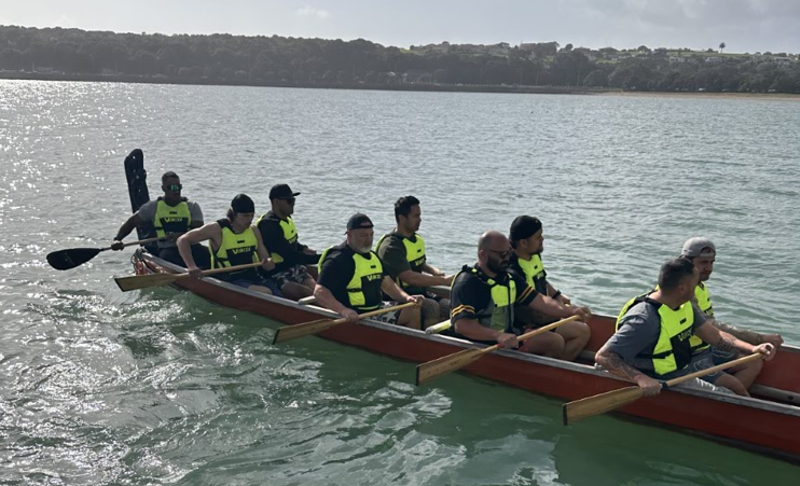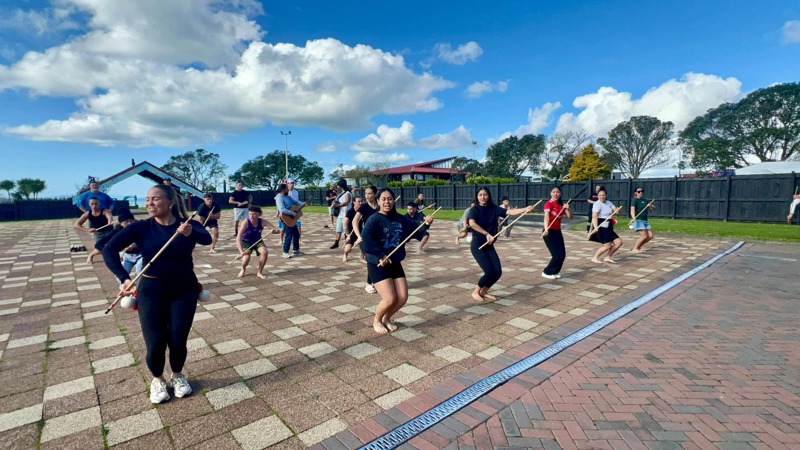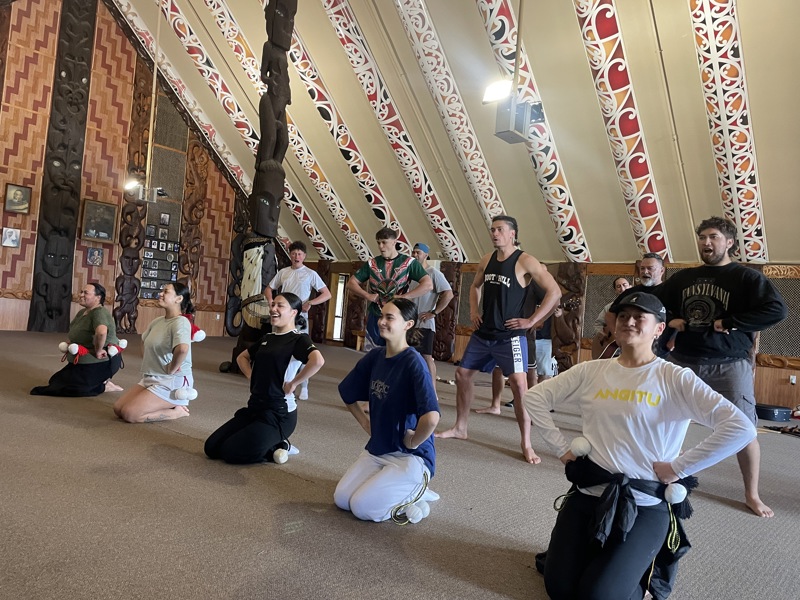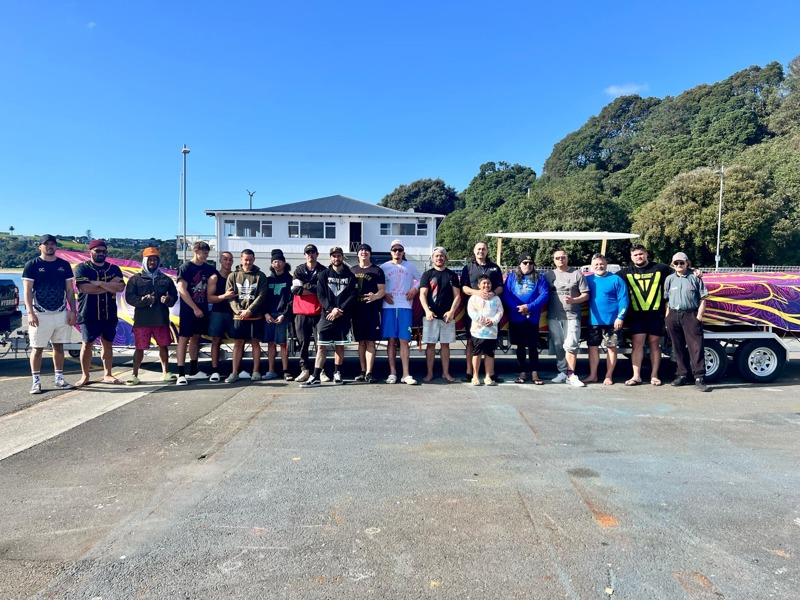Te Kawau
Rukutia tā Te Kawau rukuJump to section
-
Te Kawau ki tai
Ngāti Whātua Ōrākei is proud to present Te Kawau, a traditional Māori waka taua (canoe).
Named after the Kawau bird, known for its endurance and deep diving ability, this waka symbolises perseverance and the deep connection to the ocean shared by Māori who are the indigenous people of Aotearoa, New Zealand. Ngāti Whātua Ōrākei are the the kaitiaki, the indigenous guardians of Te Kawau. Te Kawau honours our tupuna and celebrates our ancestral connection to the moana (ocean).Te Kawau Facts:
- Launched: 23 June 2024, Ōkahu Bay
- Length: 16 meters
- Weight: 1 tonne
- Carved from: Native New Zealand Kauri
- Carved over a 2 year period
- Master Carver: Hēmi Eruera

On, 23 June, 2024 and in a stunning ceremony, Ngāti Whātua Ōrākei launched Te Kawau on to our ancestral waters of the Waitematā. I poho kawau a Ngāti Whātua Ōrākei i te whakamānutanga waka taua. This is the first time in nearly a quarter of a century that Ngāti Whātua Ōrākei has a ceremonial waka designed to showcase the deep connection to our ancestral moana (ocean) Te Waitematā and reaffirm Ngāti Whātua Ōrākei as not only tangata whenua (people of the land) but also tangata moana (people of the ocean).
Sections of a waka

Waka = Canoe, vehicle, conveyance, medium
Waka taua = War canoe
1. Tauihu (Bow)
- The front section of the waka, often elaborately carved with designs representing ancestors, gods, and important tribal stories. The tauihu serves as both a protective and spiritual element, guiding the waka through the waters.
- The inspiration for the ihu on Te Kawau waka came from Ngāti Whātua chief Apihai Te Kawau.
2. Taurapa (Stern)
- The rear section of the waka, also adorned with intricate carvings. The taurapa often symbolizes the connection to the ancestors and the spiritual guidance they provide. It is also critical for steering and balance.
3. Takere (Hull)
- The main body of the waka, carved from a single large log, typically totara. The hull is where the warriors or paddlers sit. It provides the waka with its buoyancy and stability in the water.
4. Kiato (Thwarts)
- The crossbeams that span the hull, providing structural support and seats for the paddlers. The kiato are crucial for maintaining the strength and rigidity of the waka.
5. Haumi (Connecting Pieces)
- The haumi are the joints that connect different sections of the waka, such as the bow and stern to the hull. These pieces are lashed together using traditional methods, often with flax or other natural fibers, ensuring the waka’s structural integrity.
6. Rauawa (Side Planks)
- The additional side planks that are attached to the hull to increase the height and capacity of the waka.
- The carvings along the side of the waka represent tupuna (ancestors) guiding and pushing the waka forward.
7. Tauihu Whakairo (Carvings on the Bow)
- Specific carvings on the bow of the waka, often representing protective spirits or ancestral figures. These carvings are believed to guide and protect the waka and its crew.
8. Haehae (Ribs)
- The internal framework or ribs of the waka that help maintain its shape and strength. The haehae are vital for distributing the weight of the crew and ensuring the waka’s durability.
9. Hoe (Paddles)
- The paddles used by the crew to propel the waka. The design and size of the hoe vary, with some being specifically used for steering, while others are for general paddling.
10. Aukaha (Canoe Lashings)
- The lashings that bind the various components of the waka together. These are traditionally made from materials like harakeke (flax) and are critical for the waka’s strength and flexibility.
11. Puhi (plumed rods)
Puhi, also know as mata, are the eyes, or kanohi (face) of the waka
12. Hiore
The woven cord hanging off the back of the waka is likened to the aho matua (linking back to the ocean) and te aho whenua (umbilical cord). It is also common to throw a hiore out to let the taniwha (water spirit) play with it.

Barcelona - 2024 America's Cup
Te Kawau waka travelled to Barcelona with a Ngāti Whātua Ōrākei rōpū (group) to participate in the 37th America’s Cup in 2024. The invitation to travel to Barcelona came from Emirates Team New Zealand (ETNZ) to the Ngāti Whātua Ōrākei Trust. Ngāti Whātua Ōrākei have been iwi manaaki for ETNZ for a number of years and have named their racing boats Te Aihe, Te Kākahi, Horonoku, Te Rehutai (2021 America’s Cup winner), and the most recent boat Taihoro which we were proud to name and bless in April, 2024. ETNZ and Taihoro concluded a historic chapter, winning the Louis Vuitton 37th America’s Cup after an epic final showdown in Barcelona against the Challenger of Record, INEOS Britannia.
Te Kawau and kaihoe crew escorted Taihoro and the ETNZ team from their base through the sheltered marina of the America’s Cup village each race day. In addition, the rōpū participated in various cultural performances and ceremonial events whilst in Barcelona, with many of the rōpū participating in both waka and haka activities. Read the press release here


The responsibility to represent our whānau, hapū, iwi, culture and country was not taken lightly. Waka trainings and haka practice buildup for the travelling rōpū were full on with lots to learn and lock in before departure. With strong attendance numbers at practices, the rōpū have established great whanaungatanga and excitement towards the haerenga.


Lessons for today's generations
The waka taua continues to teach valuable lessons to today’s generation, particularly within Māori communities. The values embodied by the waka taua—connection to land and sea, collective effort, resilience, and a warrior mentality—are as relevant today as they were in the past.
- Tāwhiwhi ki ngā atua: The deep relationship between the Māori people and their environment is a fundamental aspect of their identity. The waka taua serves as a reminder of the need to respect and protect the natural world, a lesson that resonates in today’s context of environmental challenges.
- Kirikawa ki te rākau, kirikawa ki te kōrero: The concept of the warrior (toa) in Māori culture goes beyond physical combat. It encompasses courage, determination, and the ability to overcome adversity. These qualities are still admired and nurtured in Māori communities today, encouraging young people to face challenges with resilience and strength.
- Kotahitanga: The collective effort required to build and operate a waka taua teaches the importance of unity and cooperation. In today’s society, this value is crucial for achieving common goals, whether in community projects, social movements, or even in family life.
- Mana Moana: The waka taua is a powerful symbol of Māori cultural identity. It serves as a tangible link to the past, reinforcing a sense of pride and belonging in today’s generation. By learning about and participating in waka traditions, young Māori can connect with their heritage, fostering a strong sense of identity and continuity.
The waka taua is much more than a historical artifact. It is a living symbol of Māori culture, embodying values and lessons that continue to guide and inspire the Māori people today. Through the waka taua, the Māori are reminded of their deep roots, their collective strength, and their ongoing journey as a people.
Creation and Traditional Practices
The creation of a waka taua is a process steeped in both physical craftsmanship and spiritual significance. The process begins with the selection of a large tree, typically a bigger tree, a Totara or Kauri. This selection was not merely a practical choice but also a spiritual one. The tree was often chosen with the guidance of tohunga (spiritual experts), who performed rituals and incantations to acknowledge the tree’s life force (mauri) and to seek permission from the gods and ancestors.
Once the tree was felled, it was hollowed out and shaped into the canoe’s form, a process that could take several years. The carving was done by expert carvers (also known as tohunga whakairo), who imbued the waka with intricate designs and symbolic patterns. These carvings often represented ancestors, deities, and important cultural stories, each contributing to the canoe's spiritual strength and the mana of the tribe. The stern (taurapa) and bow (tauihu) of the waka were particularly significant, often featuring elaborate carvings that told the story of the tribe's heritage and aspirations.
The entire process was a communal effort, requiring the labour and cooperation of many people within the tribe, from the carvers to those who gathered and prepared materials. The construction of a waka taua was also accompanied by various ceremonies and rituals, ensuring that the waka was not just a physical object but a vessel of spiritual power and tribal identity.
Cultural and Spiritual Significance
The significance of the waka taua extends beyond its practical use in warfare. For the Māori, the waka taua is a powerful symbol of their connection to the land, the sea, and their ancestors. The very act of creating and using a waka taua is a reaffirmation of these connections.
The waka taua embodies the concept of whakapapa (genealogy), linking the tribe not only to their immediate ancestors but to the gods and the natural world. The sea, rivers, and lakes are considered sacred, and the waka taua, as a vessel that moves through these waters, is seen as a sacred entity as well. This connection to the water symbolizes the tribe’s journey through life, their challenges, and their aspirations.
The communal nature of the waka taua also teaches important lessons about collective effort and unity. The construction and operation of a waka taua require the coordinated efforts of many individuals, each contributing their skills and labour for the good of the whole. This reflects the Māori value of kotahitanga (unity), where the strength of the group is seen as more important than individual glory.
Functions in Historical Context
Historically, waka taua were integral to Māori conflict resolution and the settlement of political disputes. Some large war canoes could carry up to 100 warriors and were used primarily for coastal and riverine warfare. The design of the waka allowed for both speed and manoeuvrability, crucial for surprise attacks and the transportation of warriors to and from battlefields.
Waka taua were more than just tools of war; they were symbols of a tribe’s power and prestige. The launching of a waka taua was a significant event, often accompanied by a dawn ceremony (karakia-Whakmānutanga waka) to bless the waka and its crew. These canoes were used to transport warriors, supplies, and sometimes entire communities across the waterways of Aotearoa. They played a central role in the inter-tribal warfare that was common in pre-European New Zealand, where disputes over land, resources, and honor were often settled through combat.
In battle, the sight of a fully manned waka taua approaching was a formidable one. Warriors would chant, shout, and perform haka (war dances) to intimidate their enemies, with the waka itself often serving as a psychological weapon due to its sheer size, the mana of its carvings, and the ferocity of its crew.
Te Kawau Docuseries
In partnership with Aotearoa Media Collective and Radio New Zealand, a docuseries was commissioned to capture the building process of Te Kawau waka right up to the launch day. TE KAWAU KI TAI docu-series consists of 6 x 10 minute episodes and includes footage of the waka build and interviews with key people across the waka build journey, and our whānau moana and waka experts.
Watch all episodes below